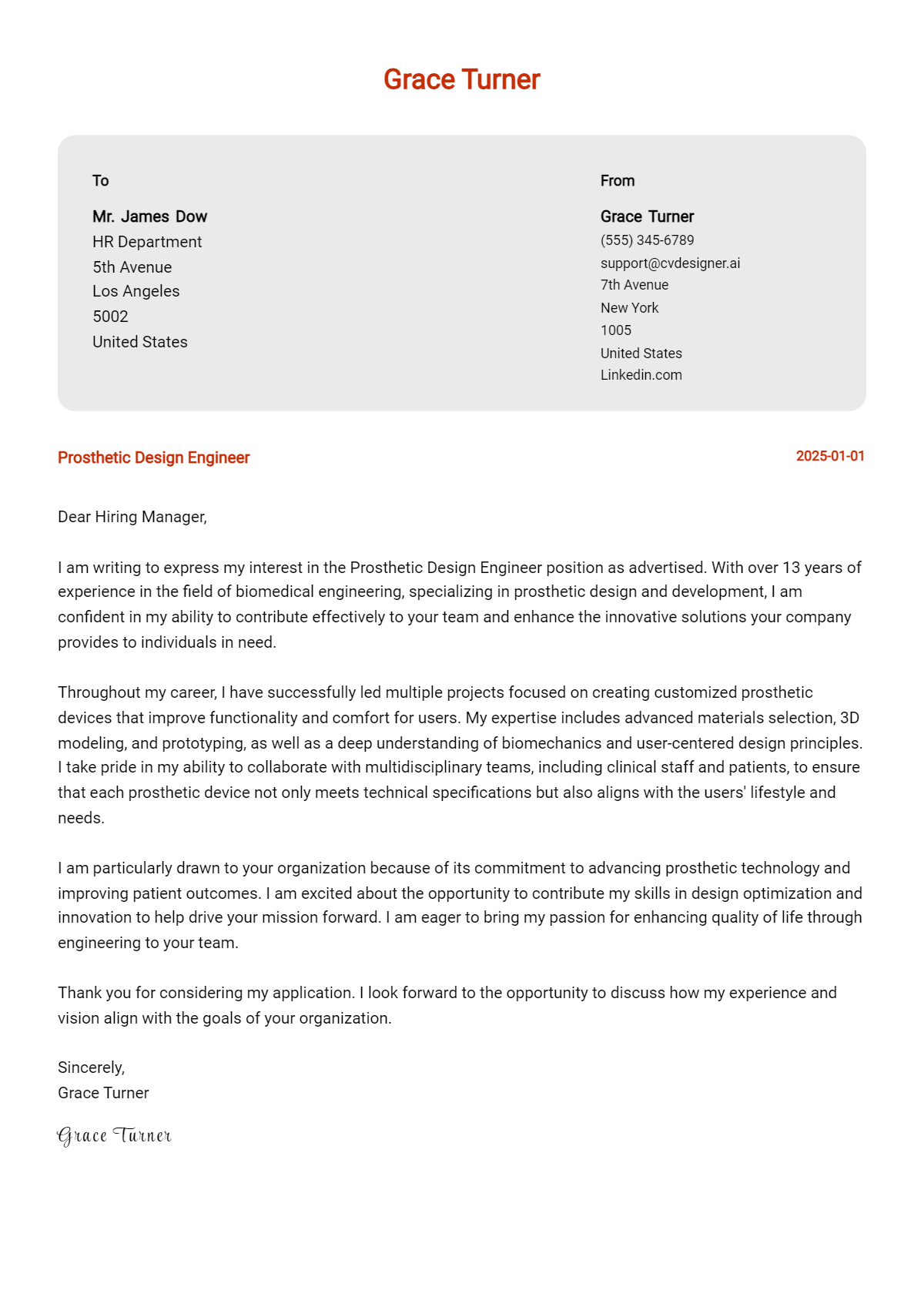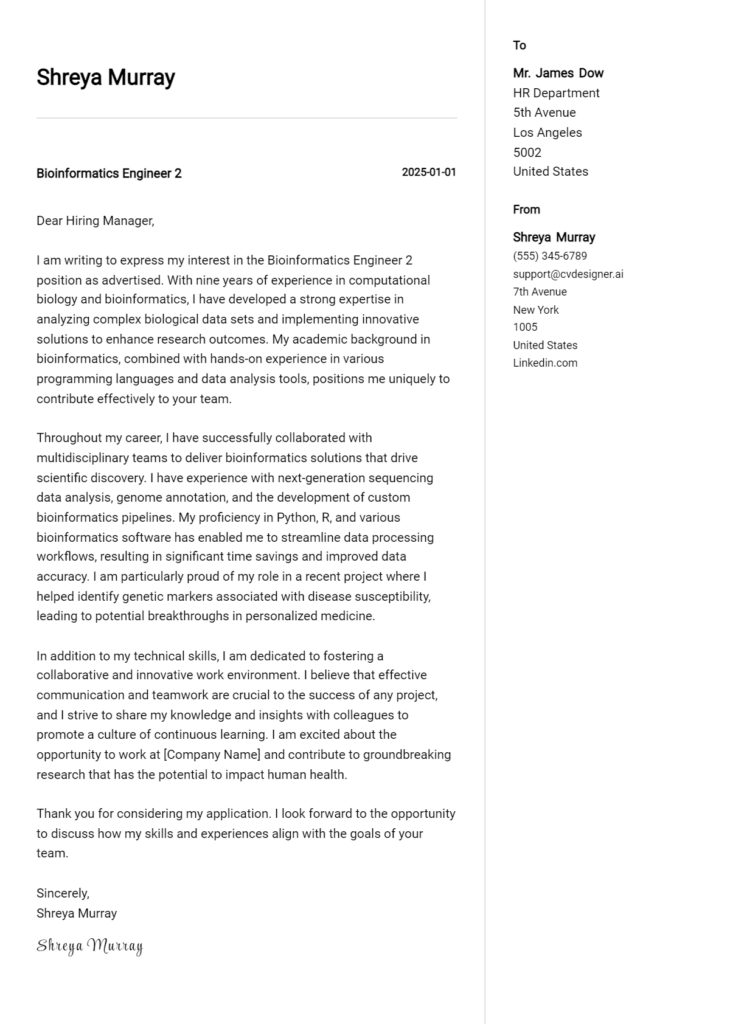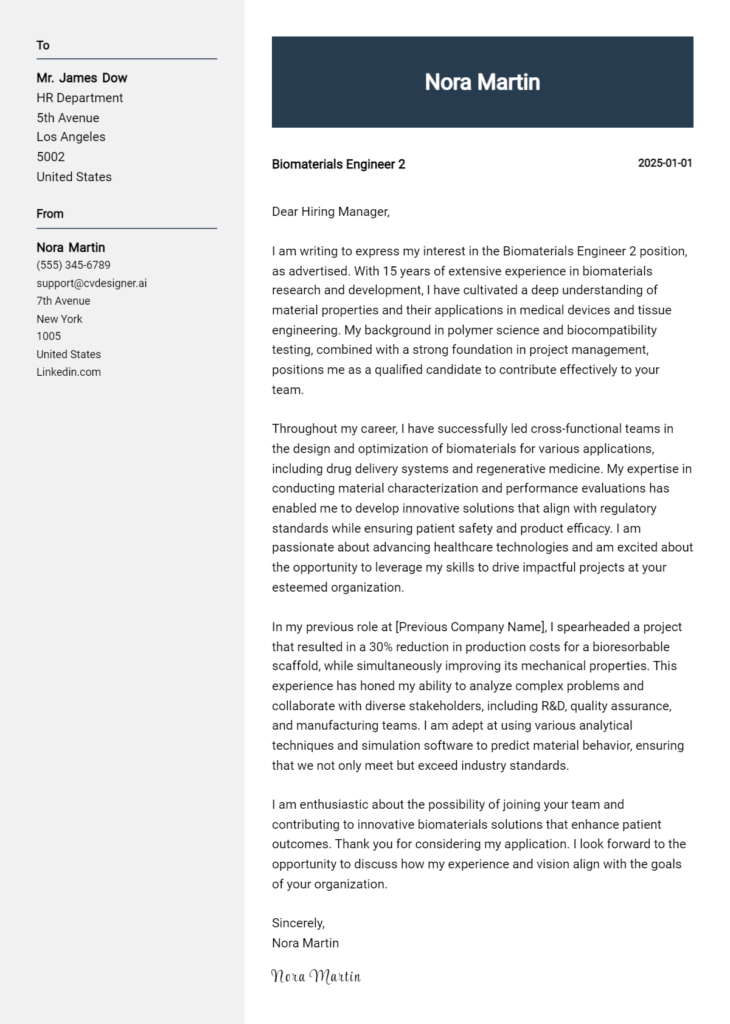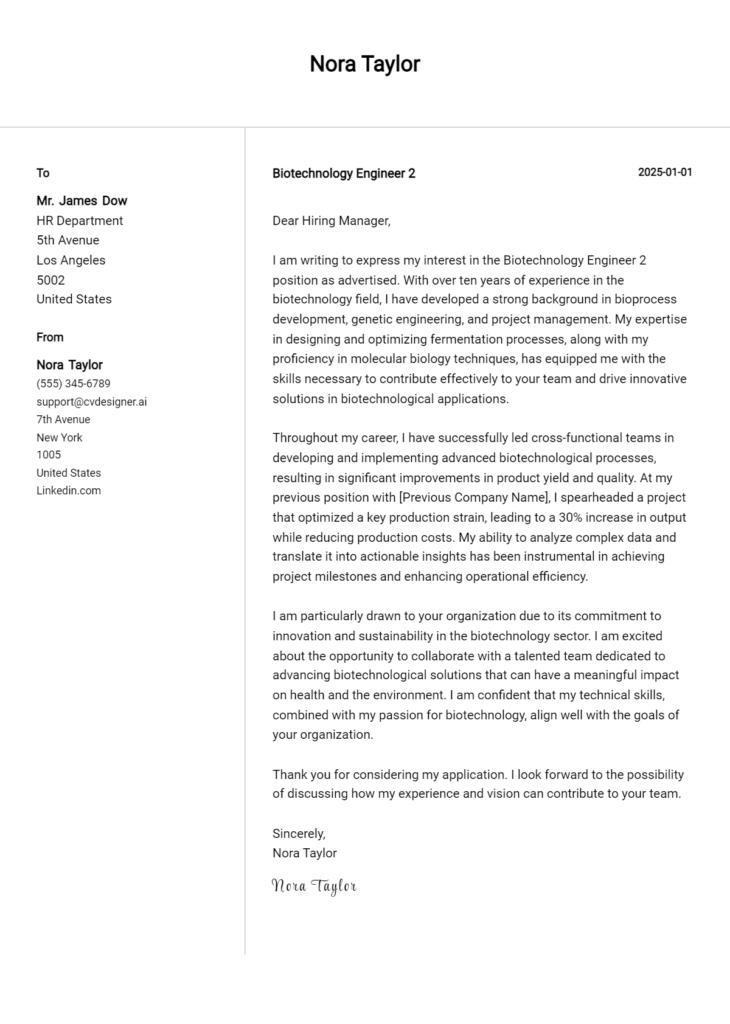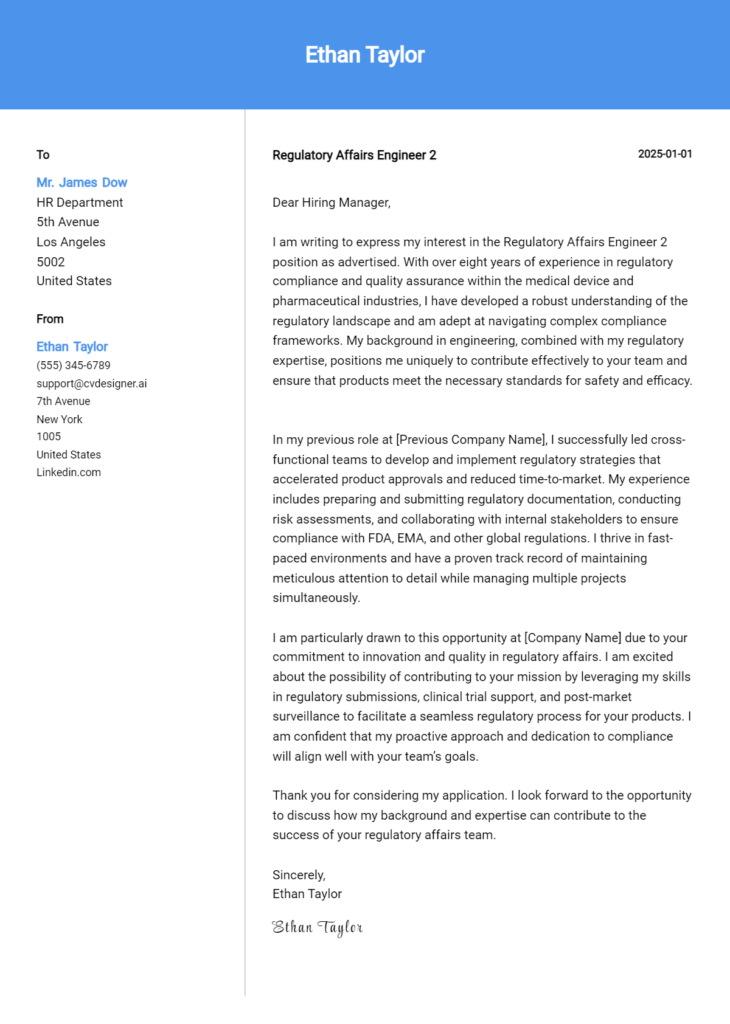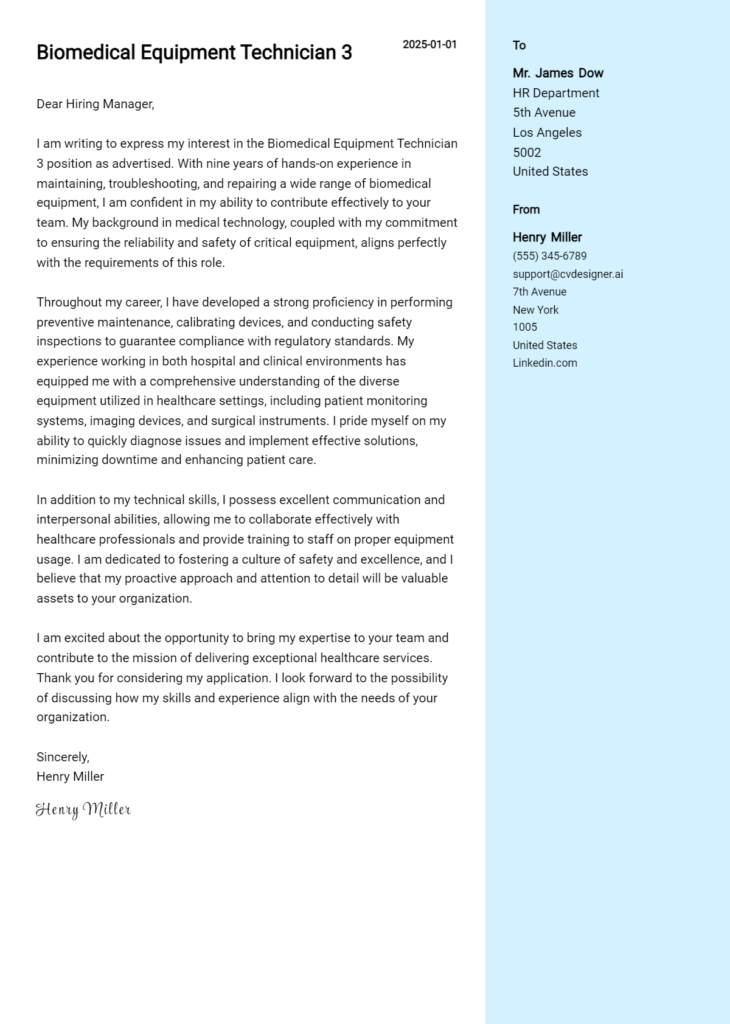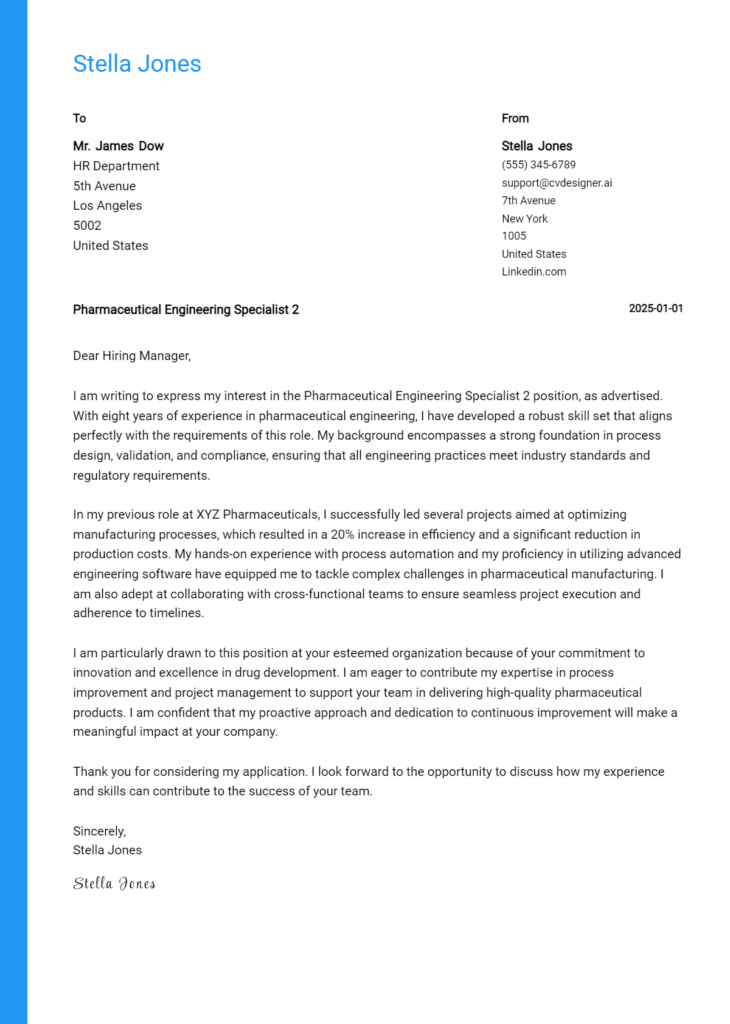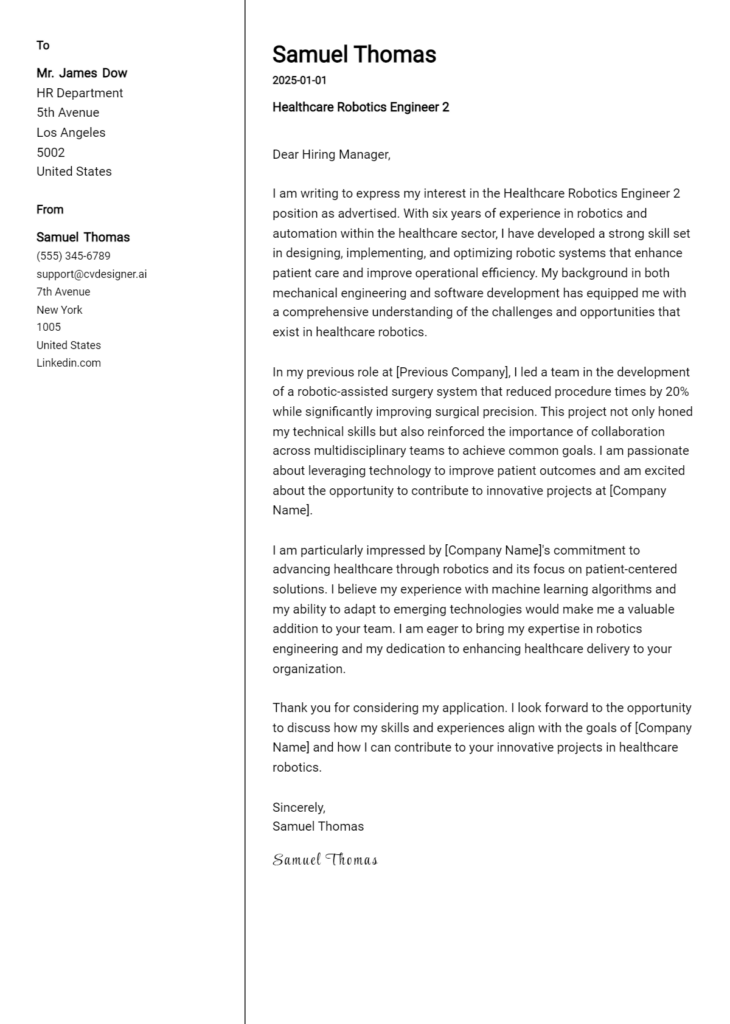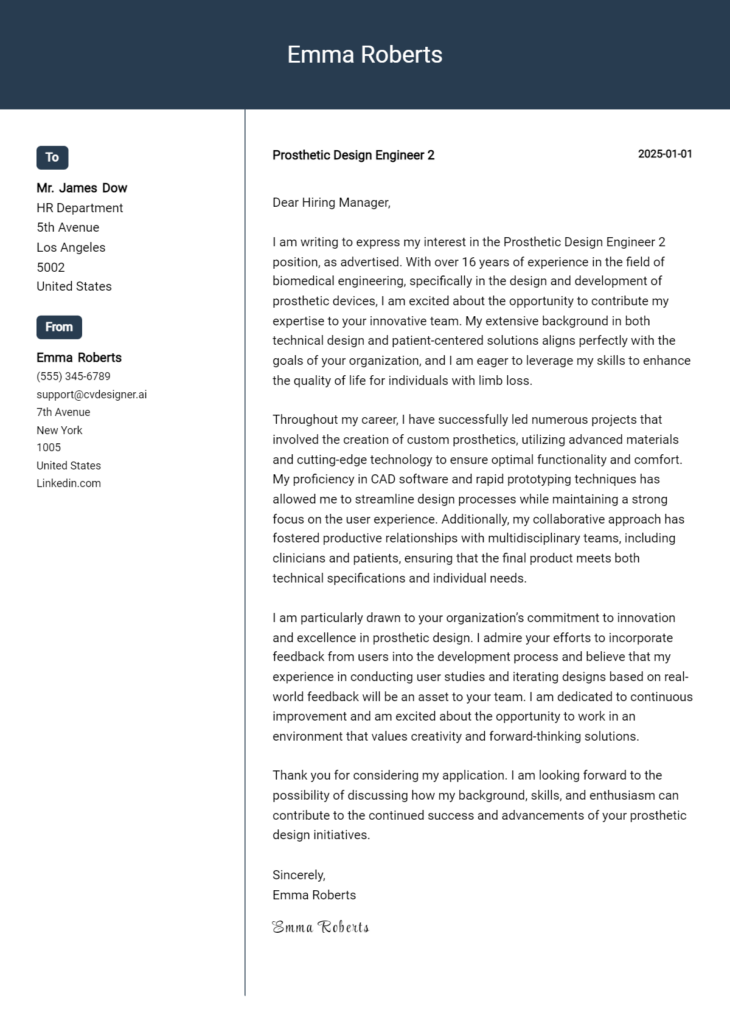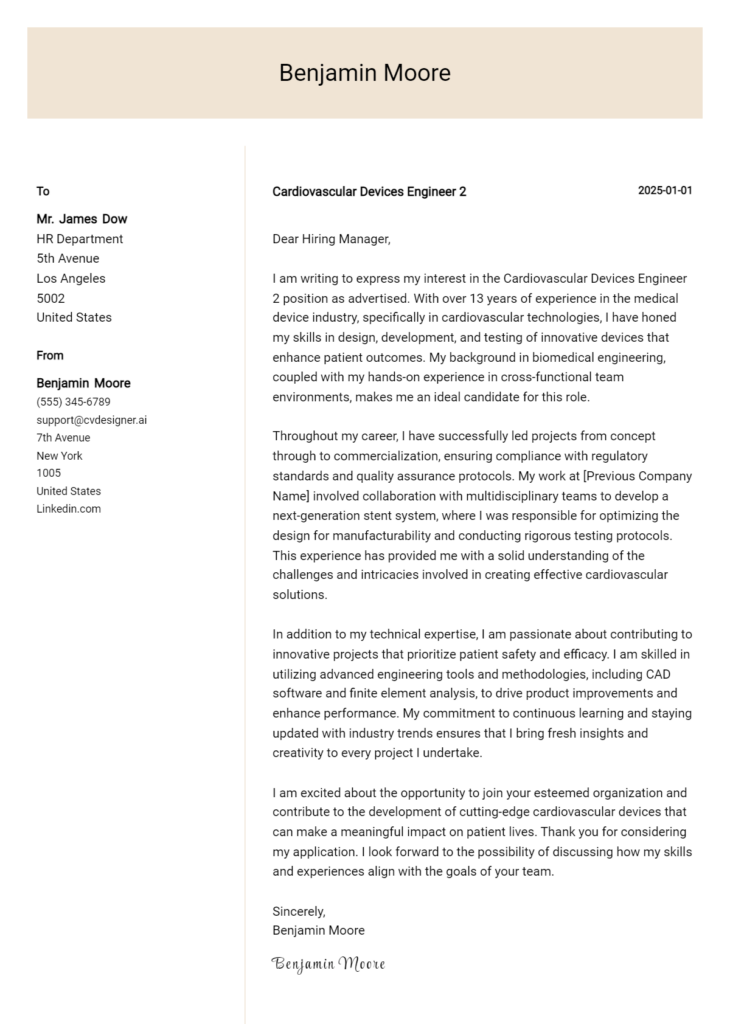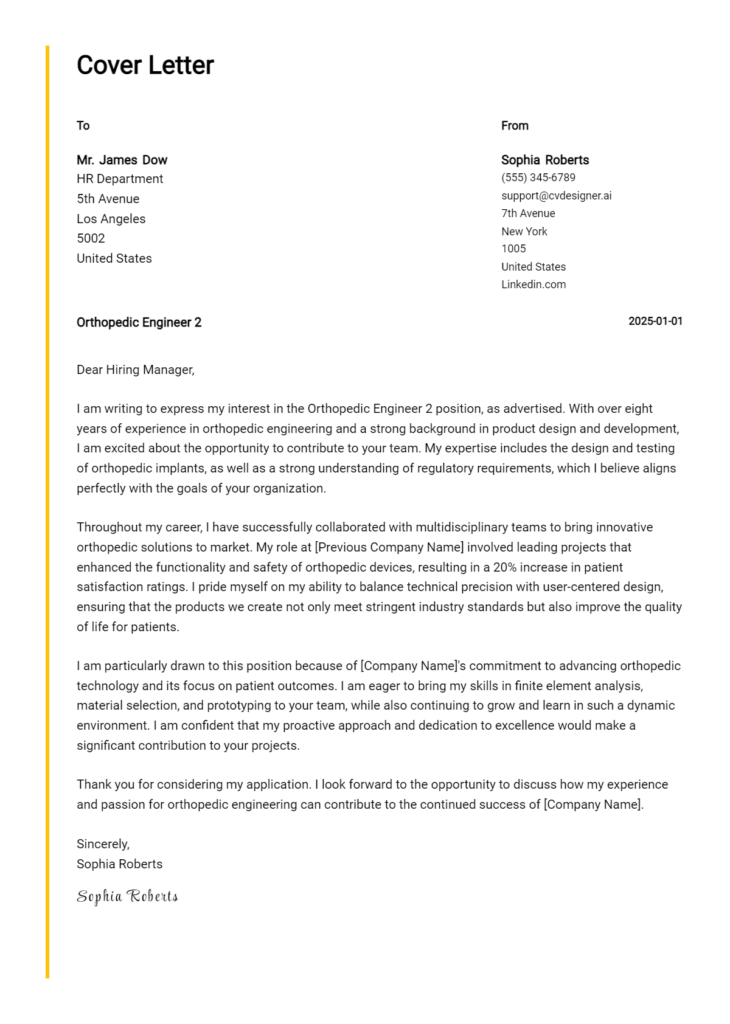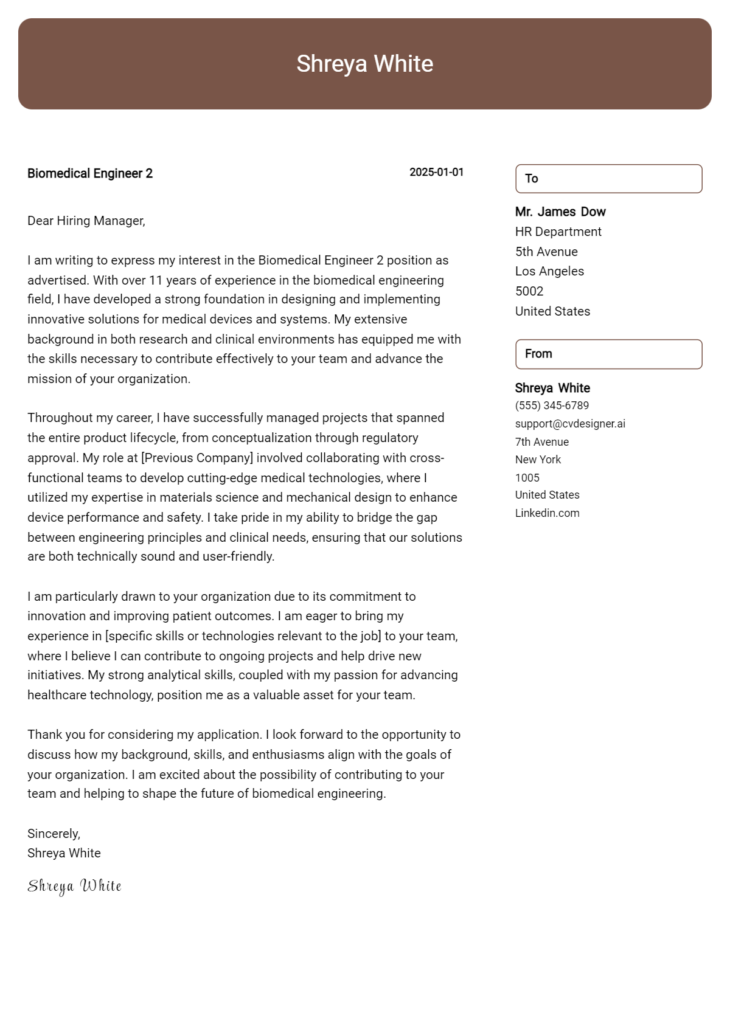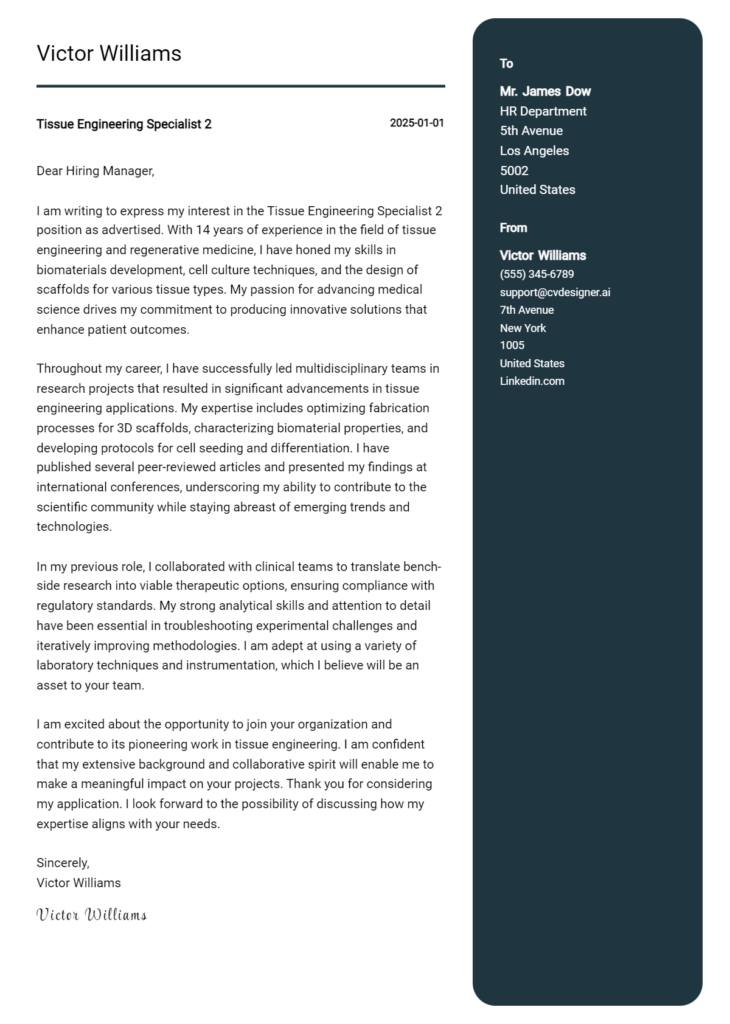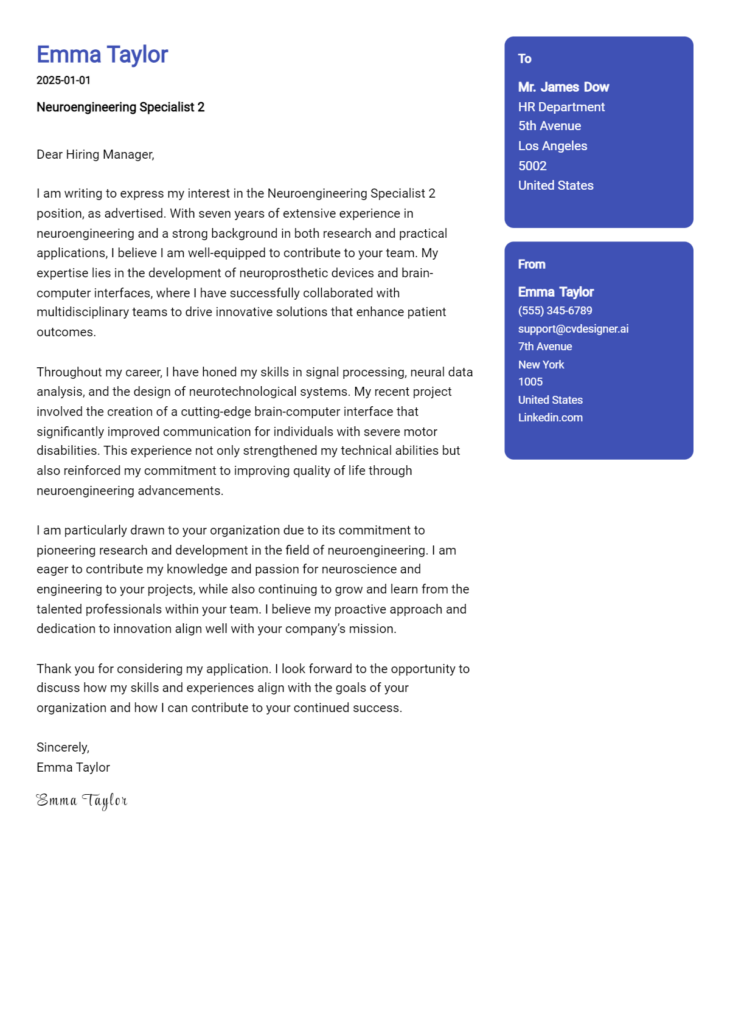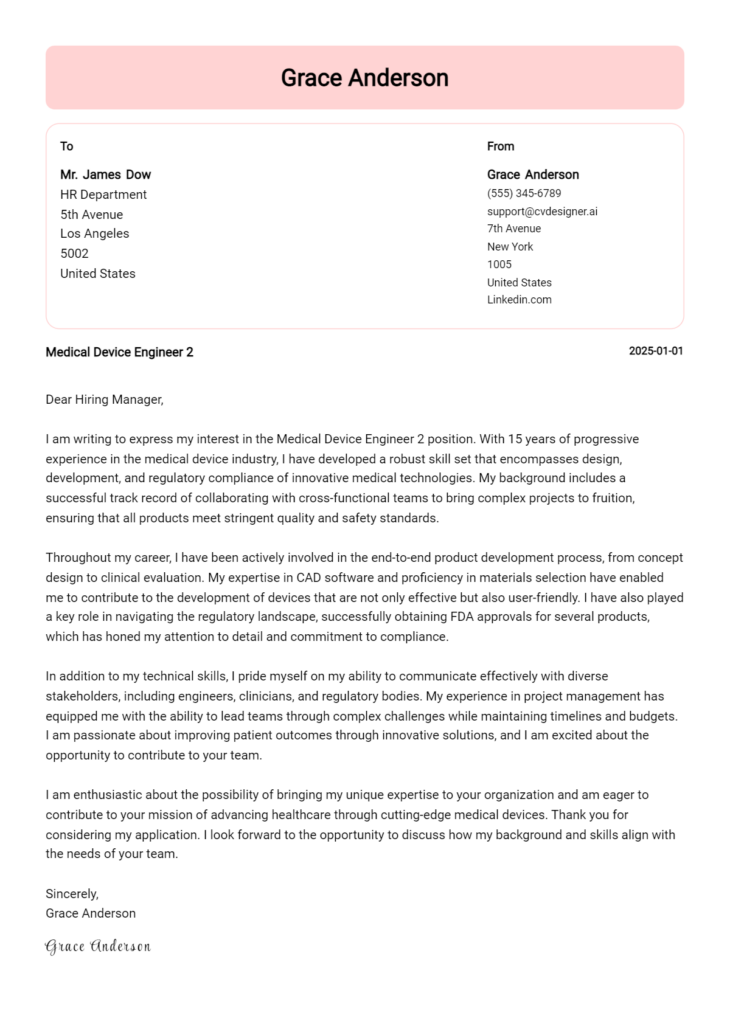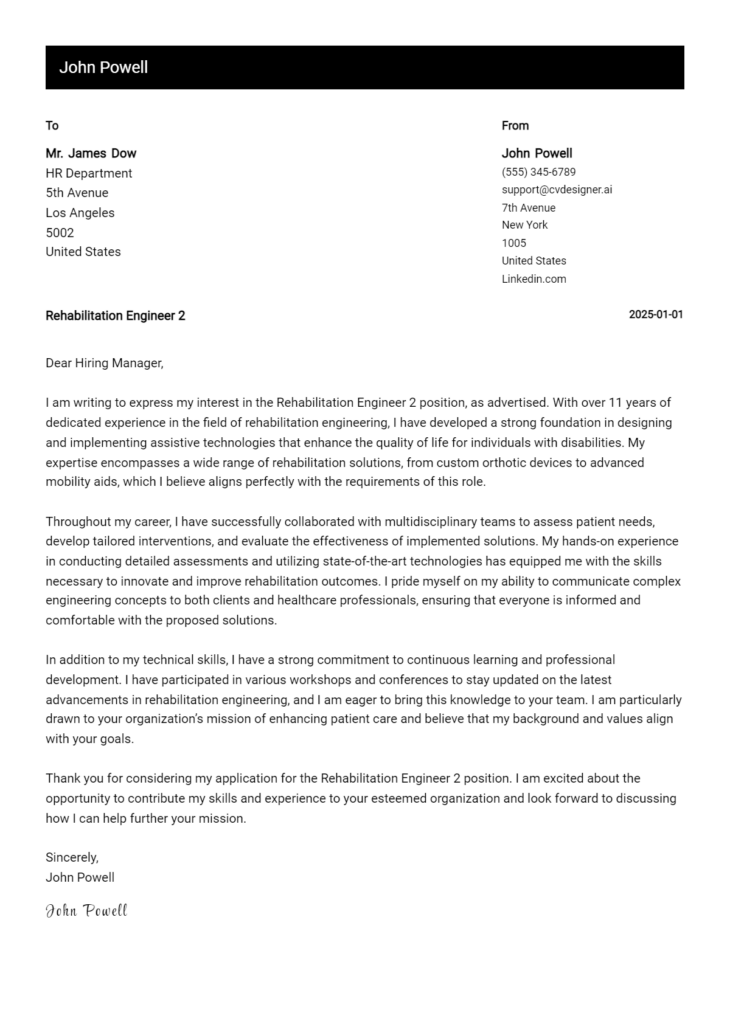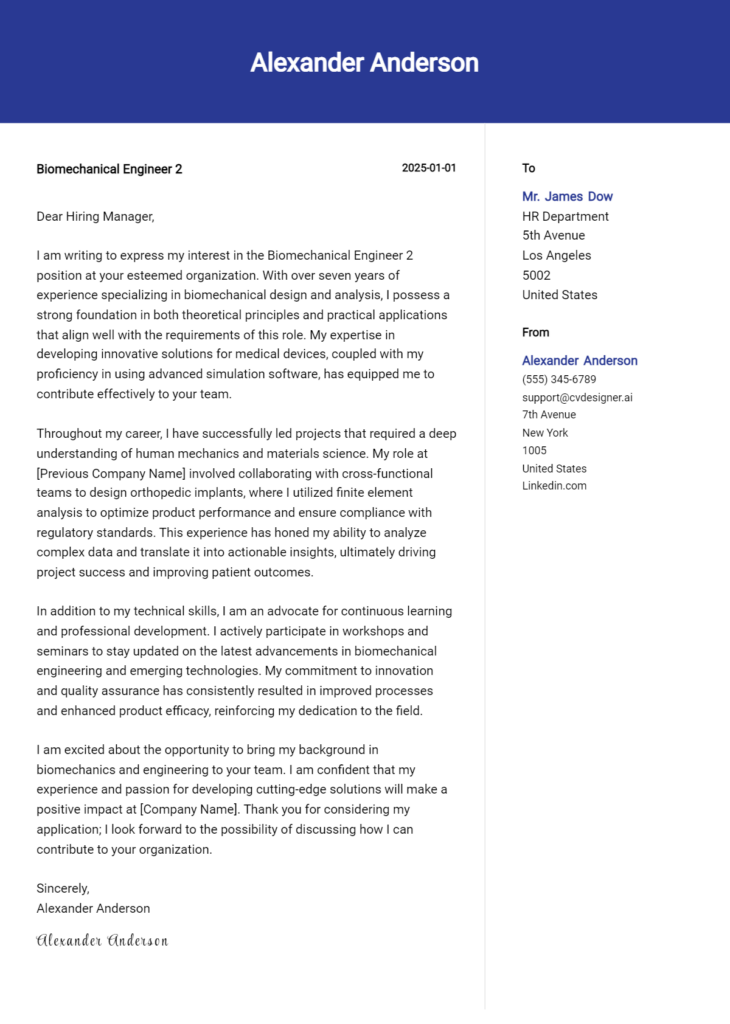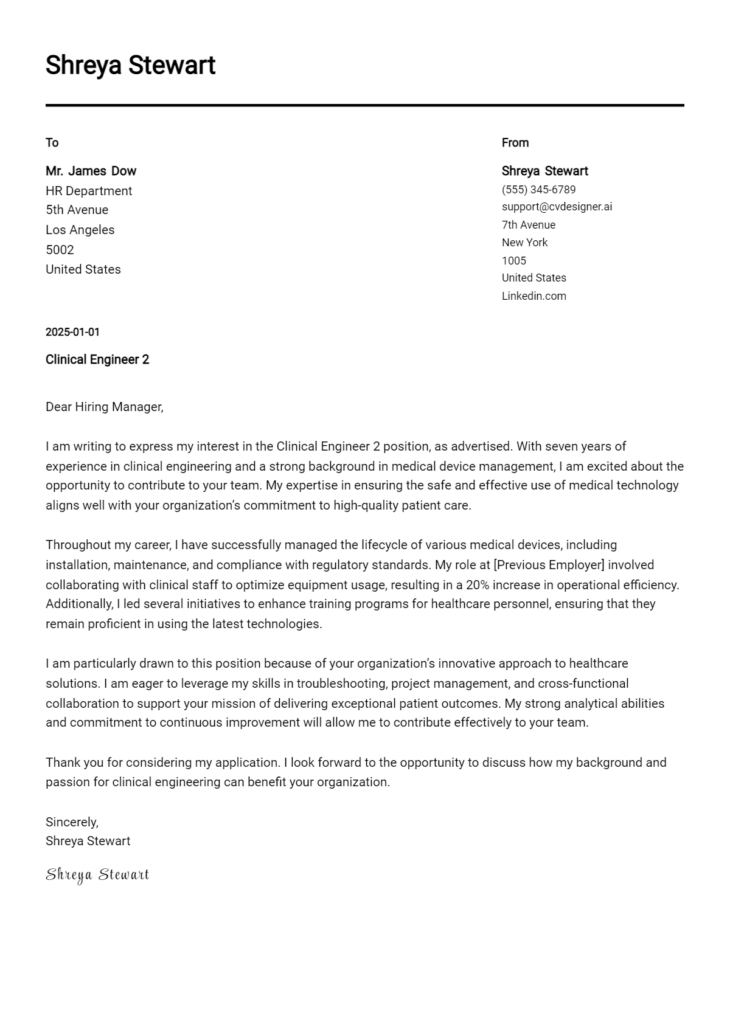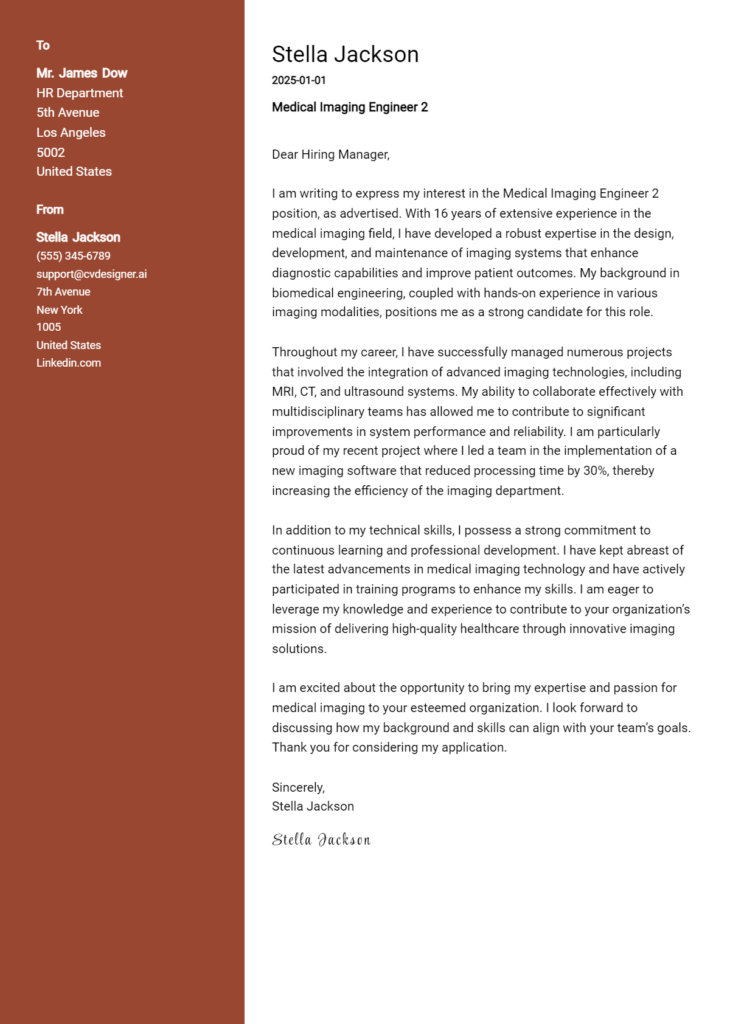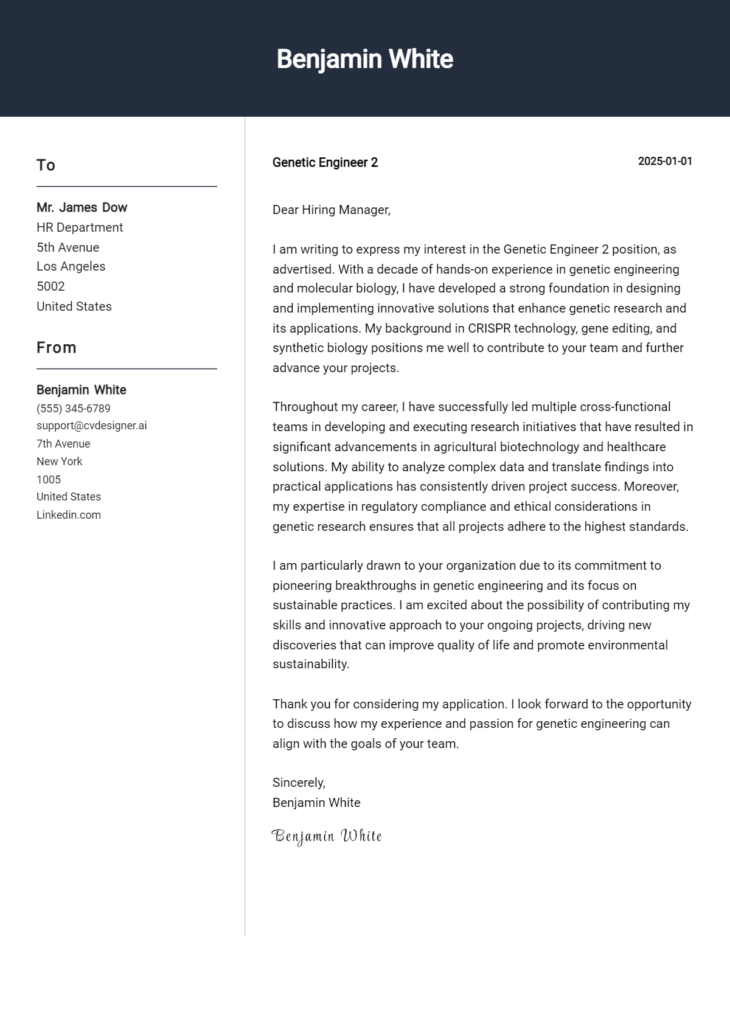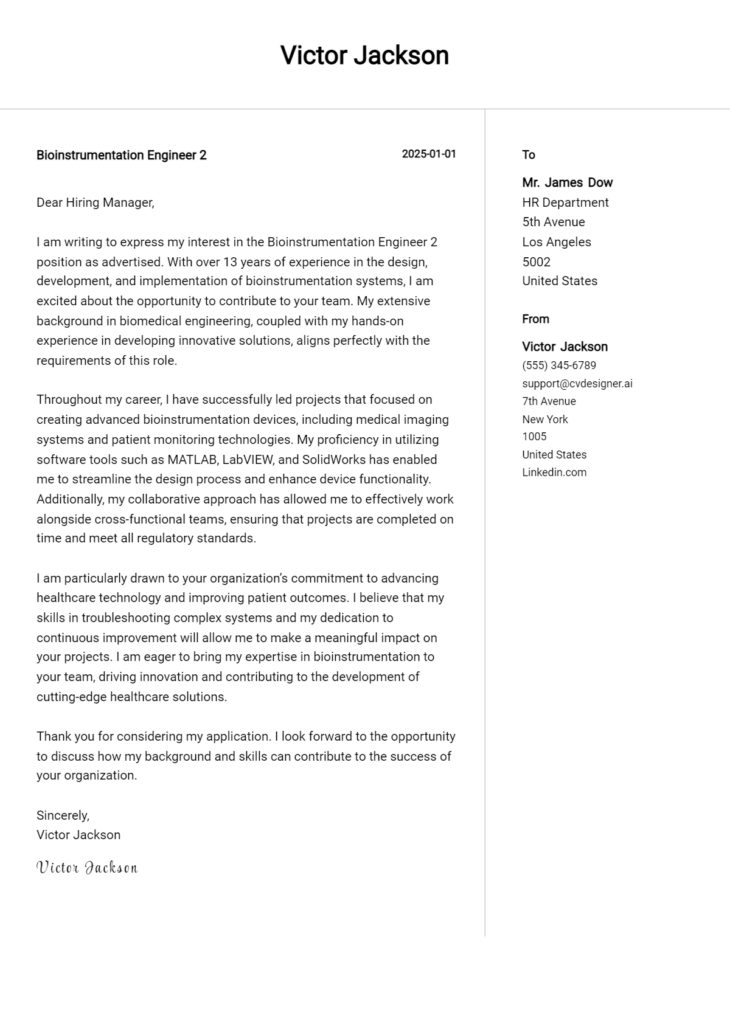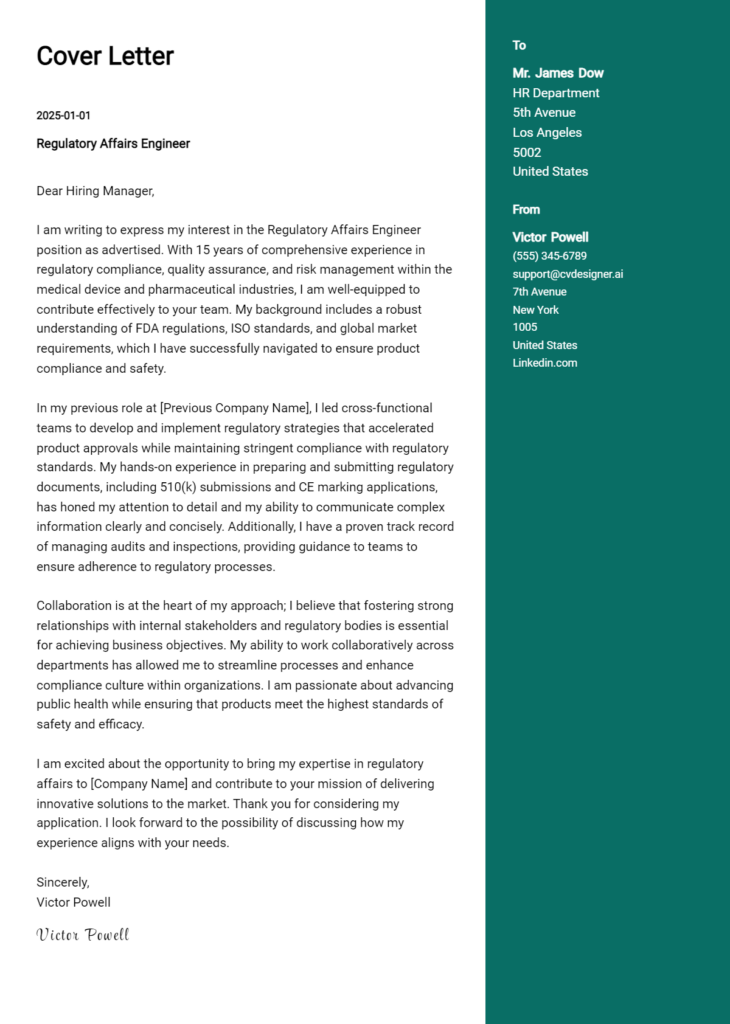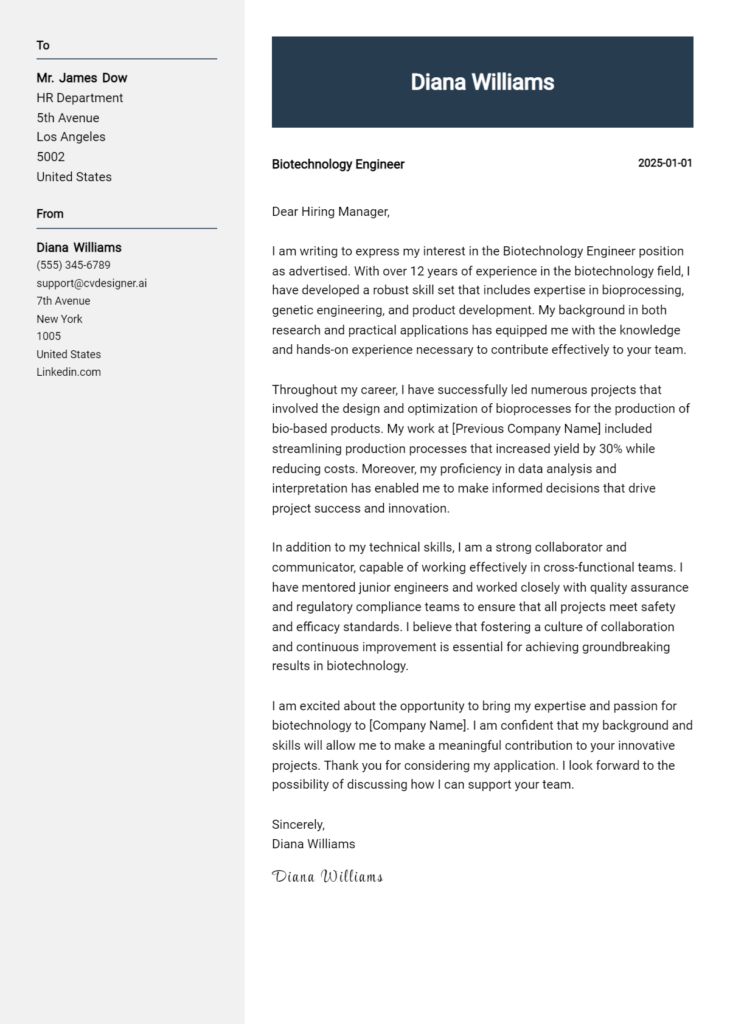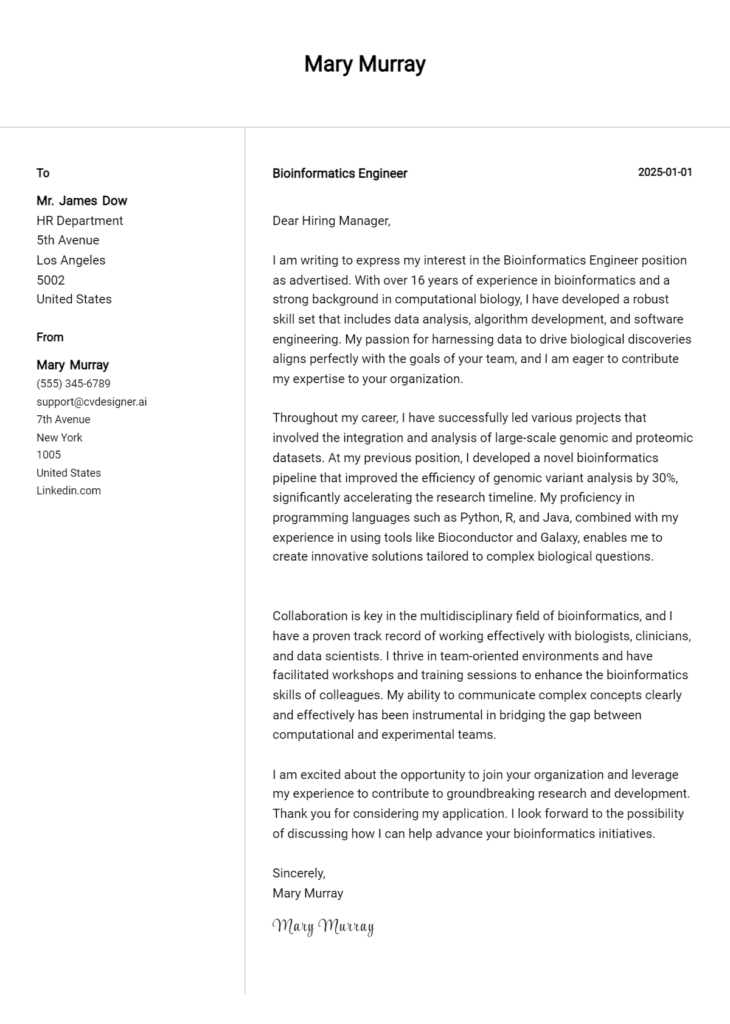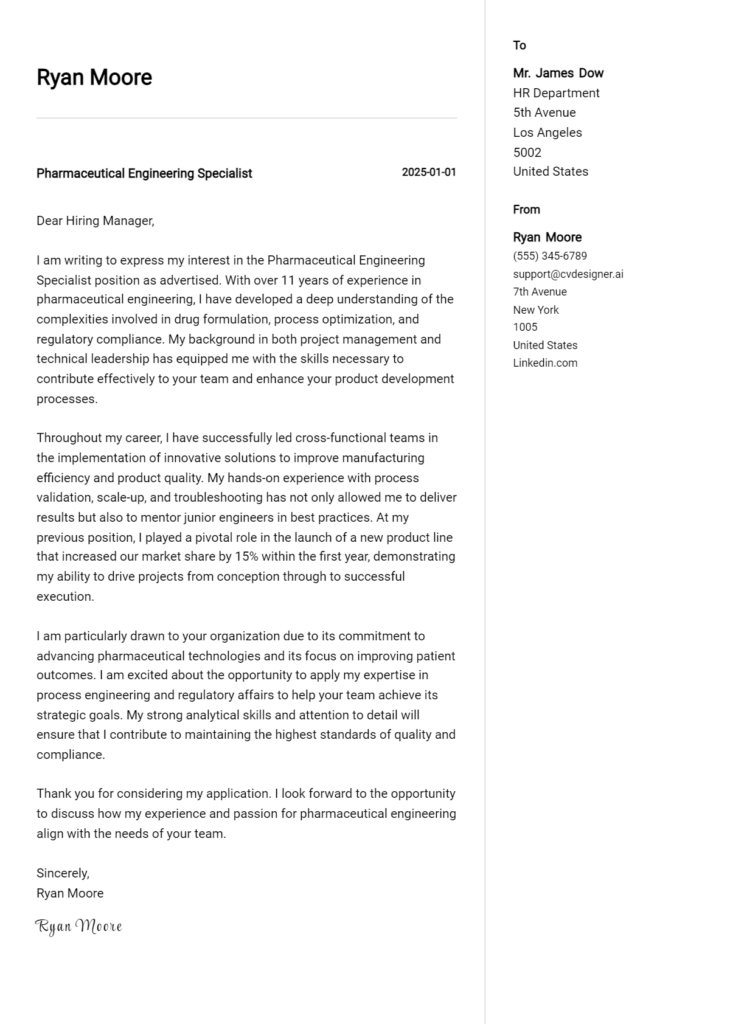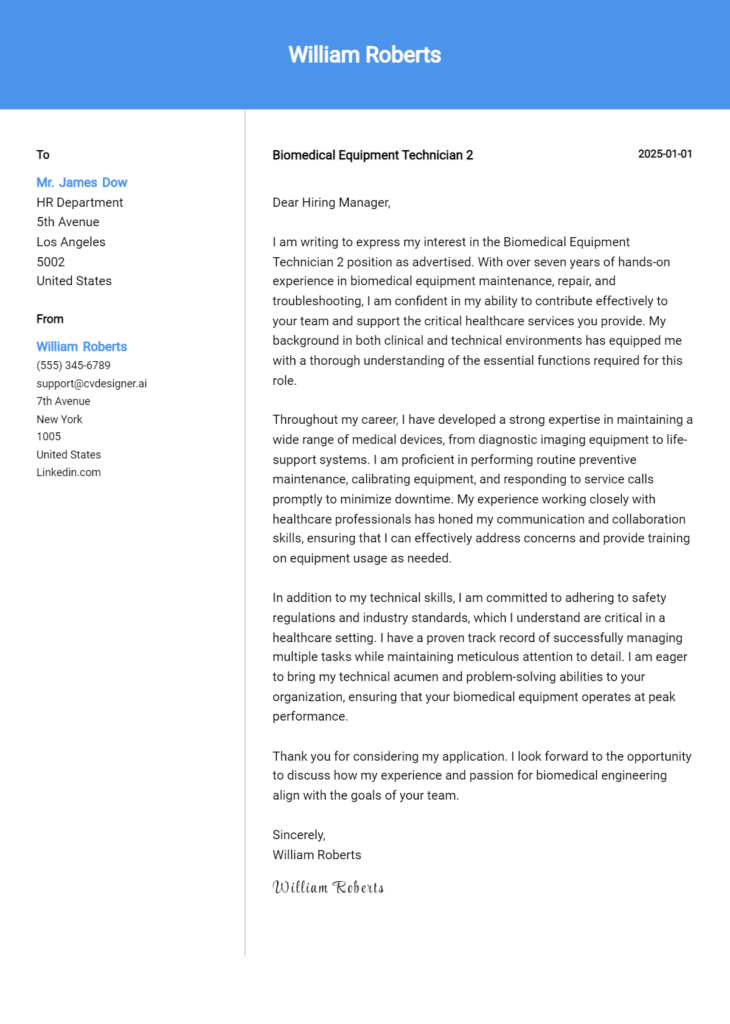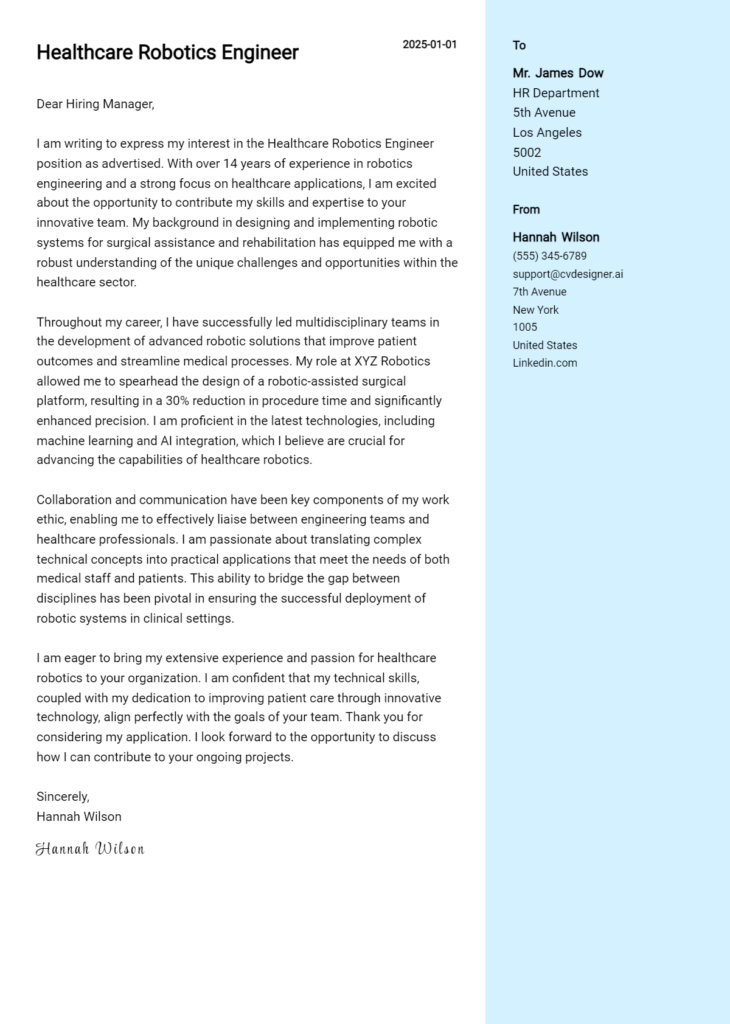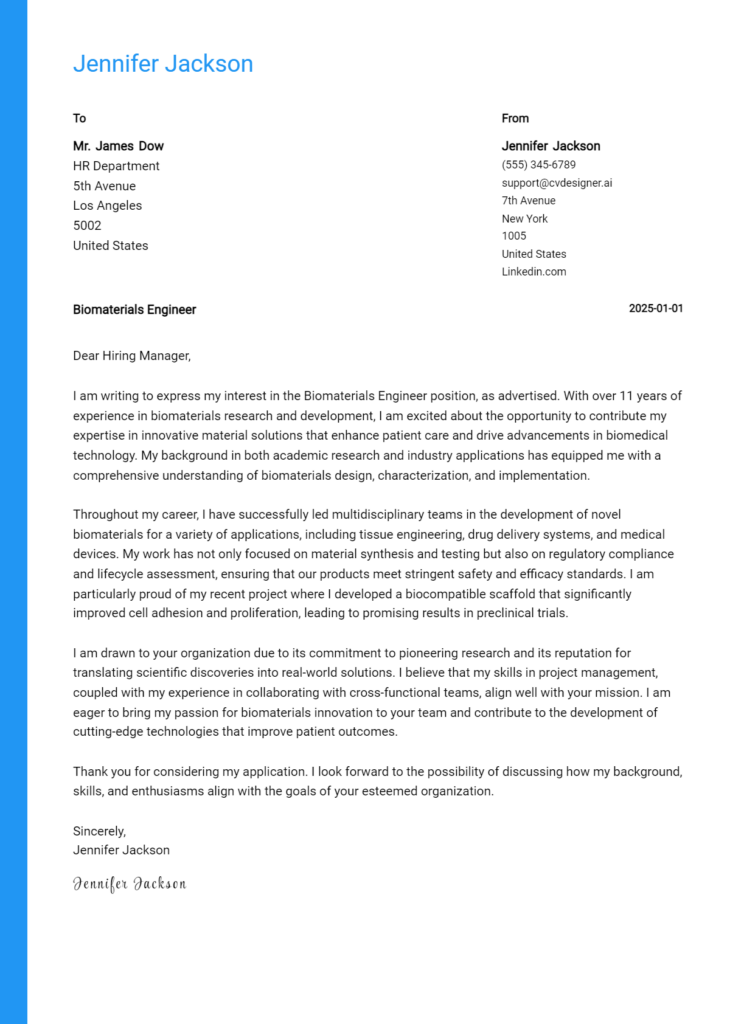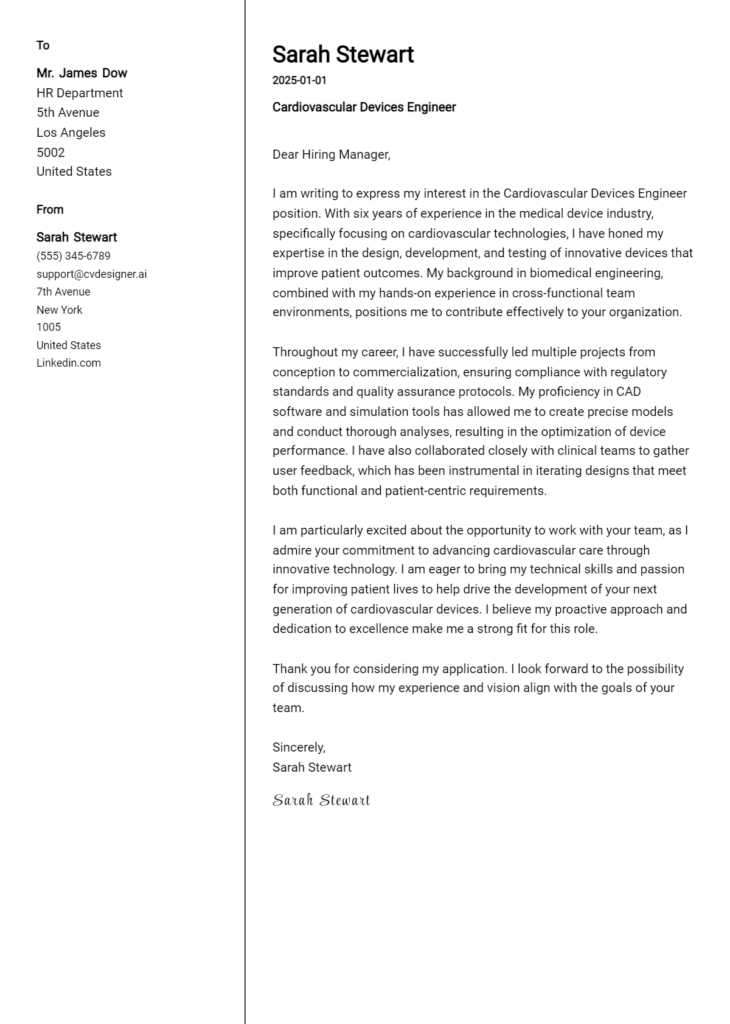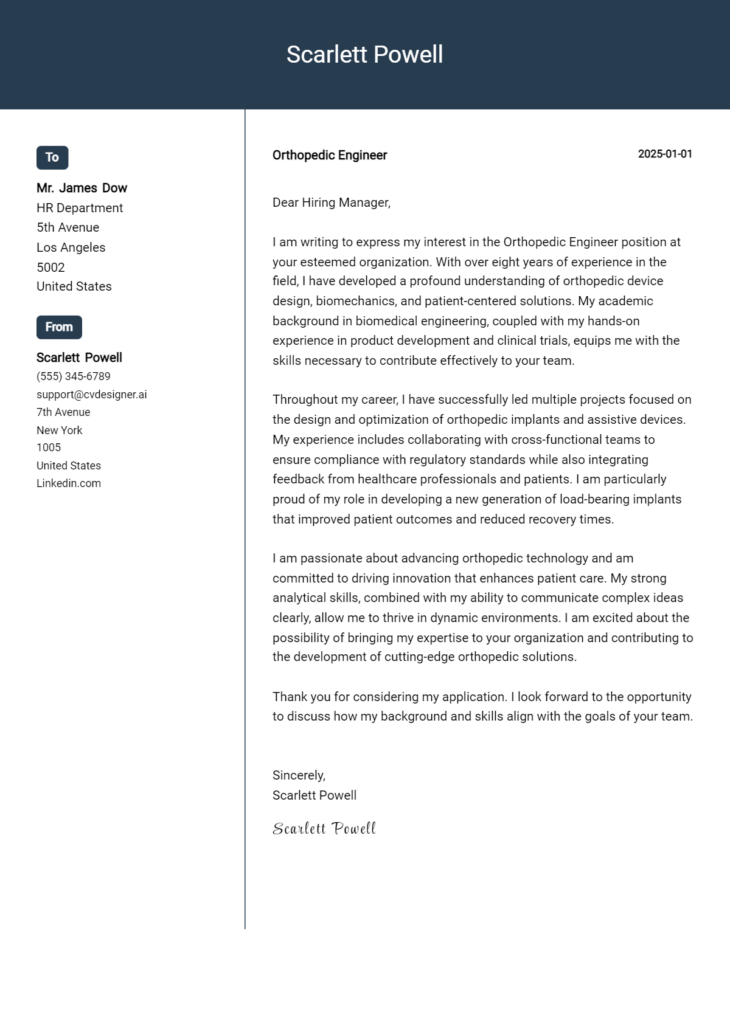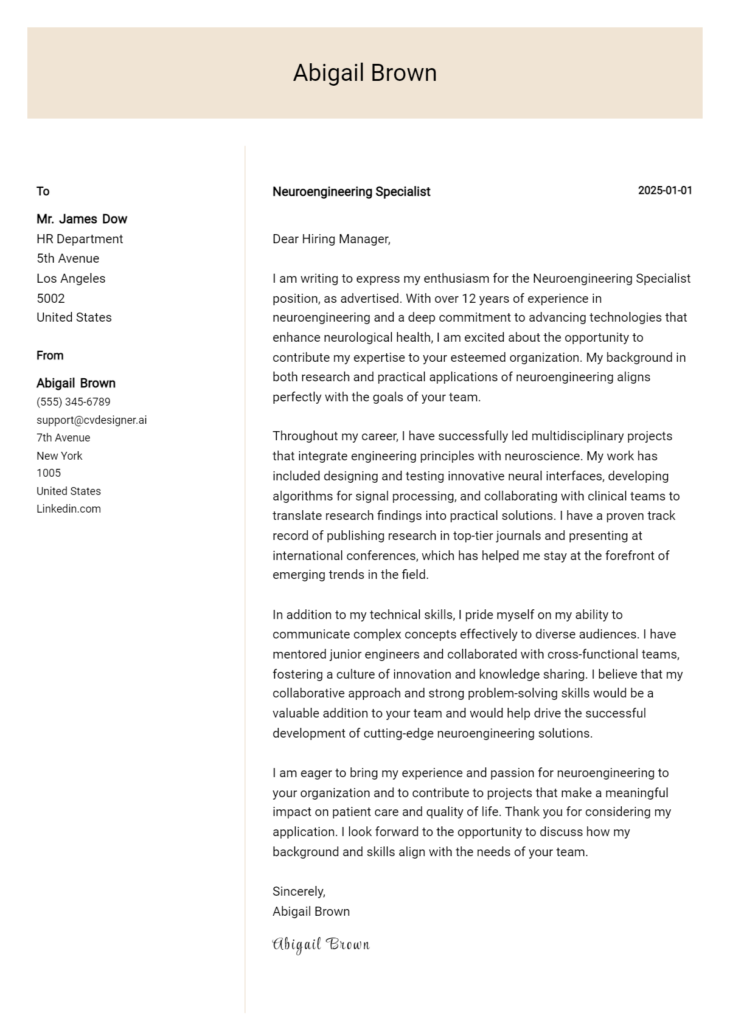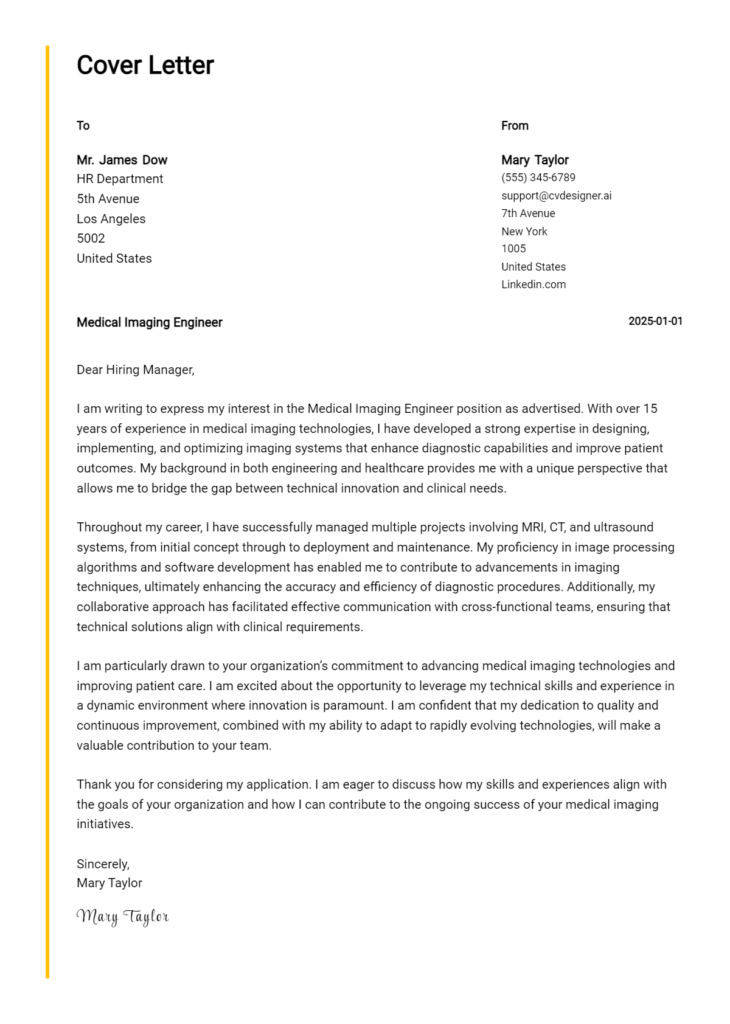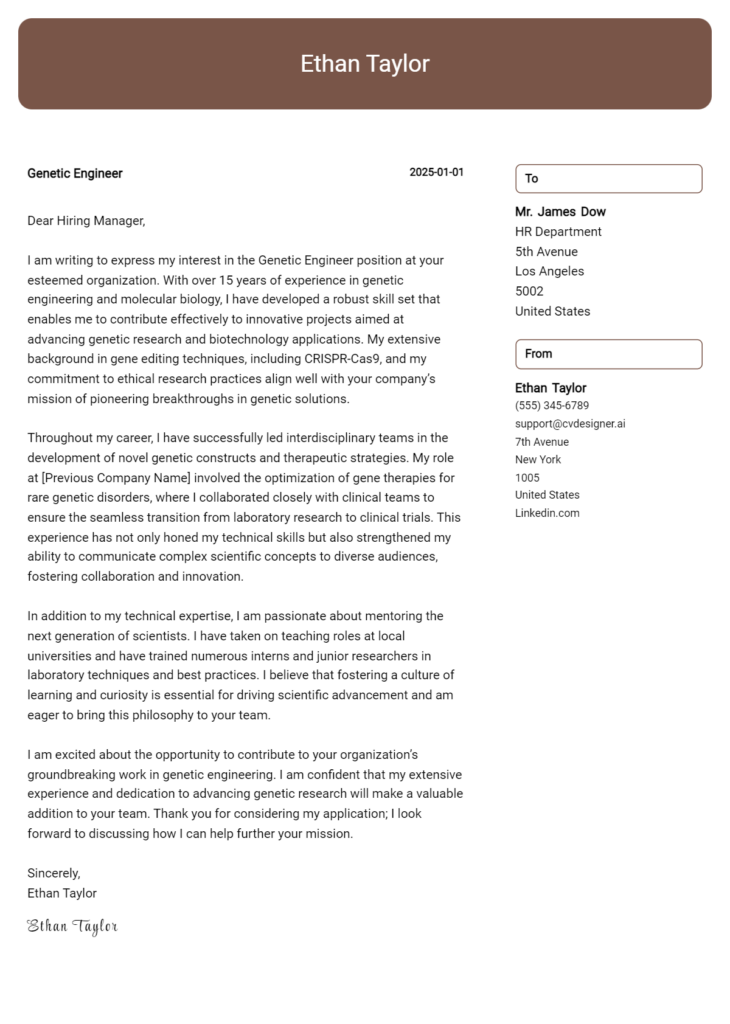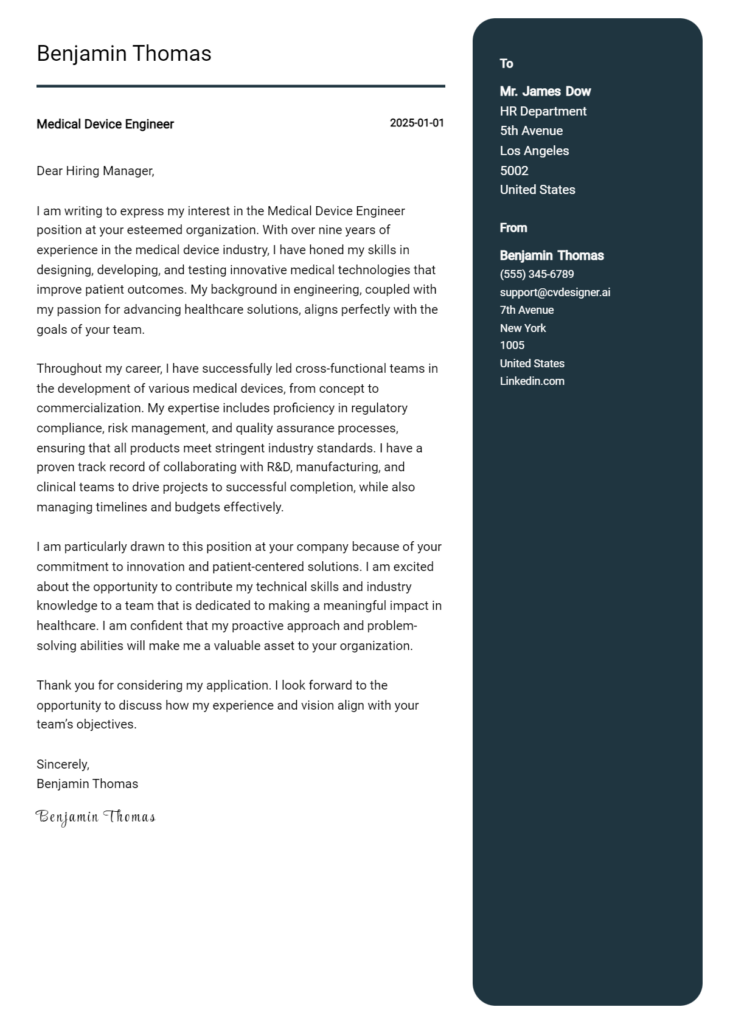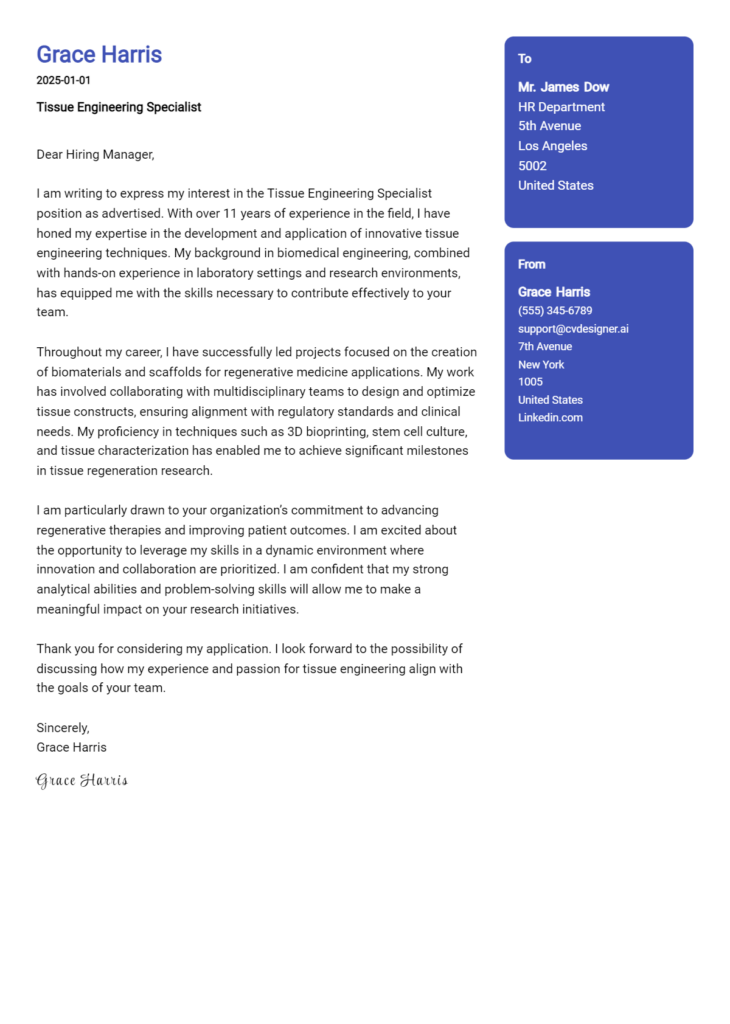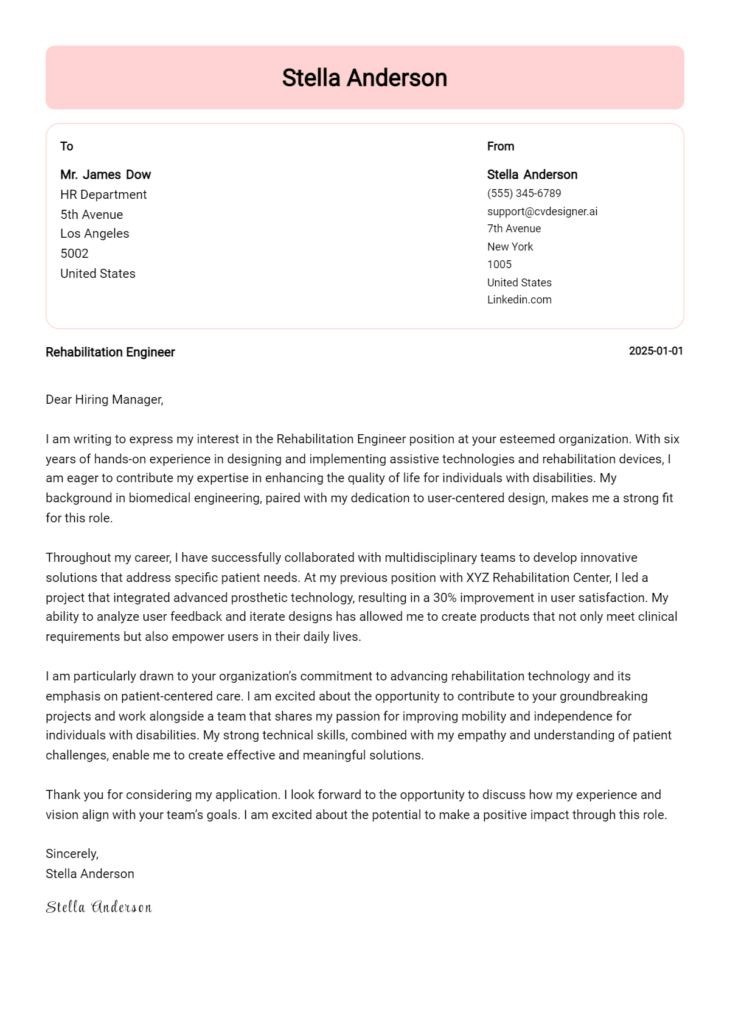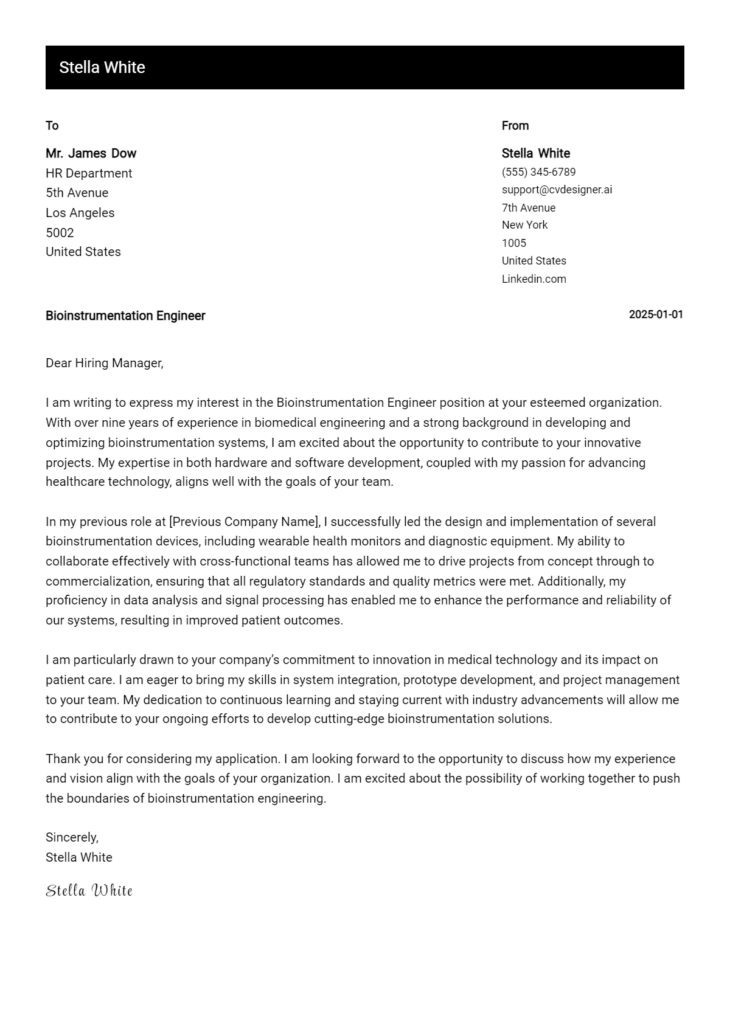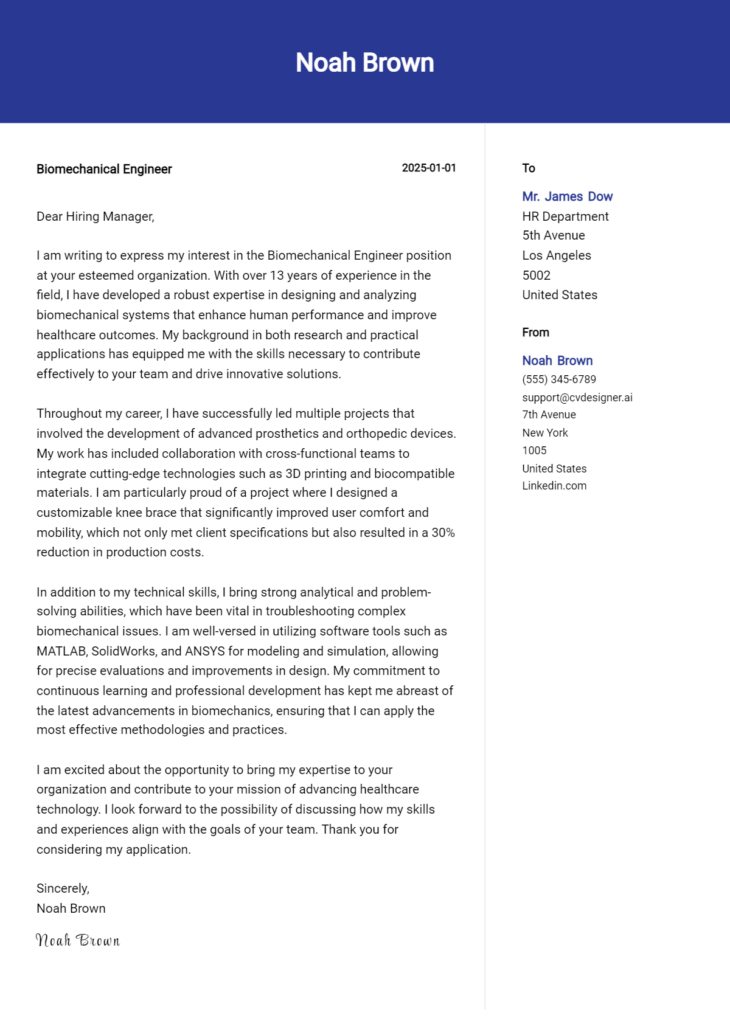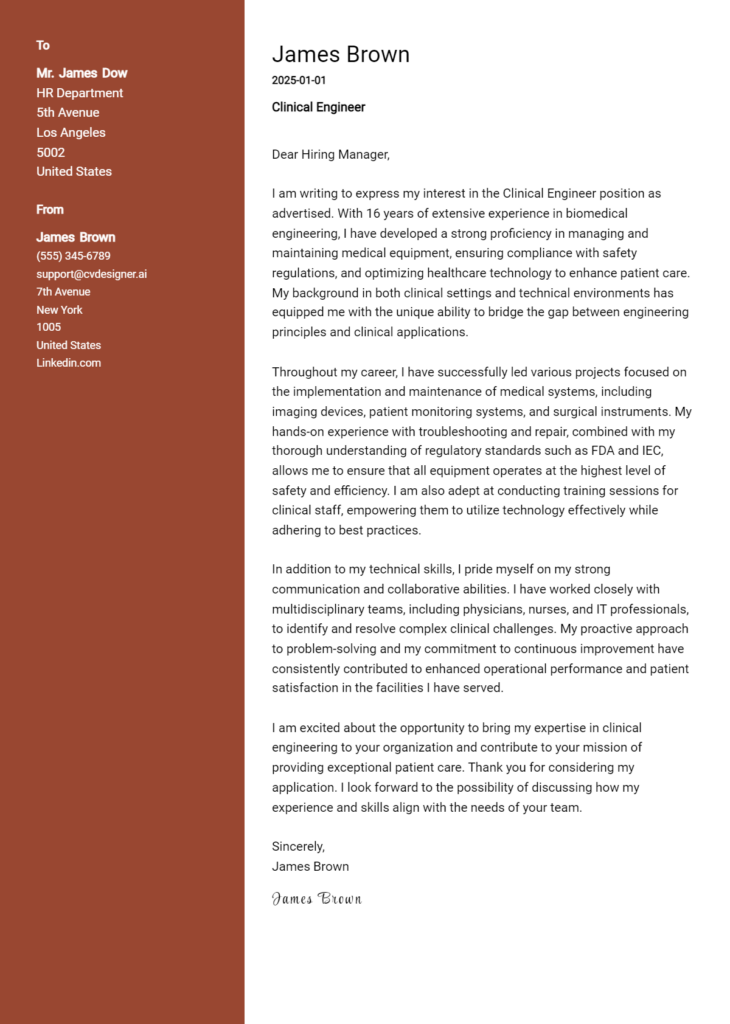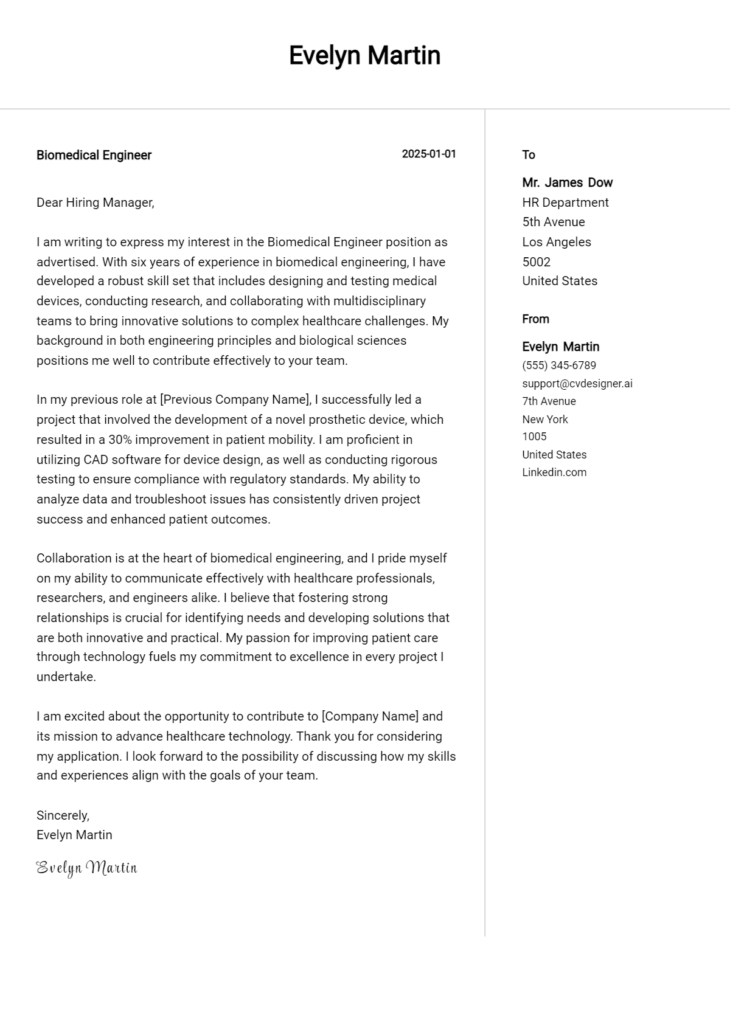Prosthetic Design Engineer Cover Letter Examples
Explore additional Prosthetic Design Engineer cover letter samples and guides and see what works for your level of experience or role.
How to Format a Prosthetic Design Engineer Cover Letter?
Crafting a compelling cover letter is essential for a Prosthetic Design Engineer, as it not only showcases your technical skills but also reflects your creativity and understanding of the user’s needs. The structure of your cover letter is pivotal in capturing the attention of hiring managers, demonstrating your ability to blend engineering expertise with empathetic design—a critical aspect in the field of prosthetics.
In this guide, we will explore how to effectively format your cover letter, providing insights and examples tailored for prosthetic design engineers.
We will focus on the essential components of a professional cover letter, including:
- Cover Letter Header
- Cover Letter Greeting
- Cover Letter Introduction
- Cover Letter Body
- Cover Letter Closing
Each section is crucial in highlighting your qualifications and dedication to improving lives through innovative design. Let’s break down each part to help your cover letter make a lasting impression.
Importance of the Cover Letter Header for a Prosthetic Design Engineer
A well-structured cover letter header is essential for a Prosthetic Design Engineer as it sets the tone for the entire application. It provides important information at a glance, ensuring clarity and professionalism. The header should include the applicant's contact information, the date, and the recipient's details. This organization not only reflects attention to detail but also makes it easier for hiring managers to identify and contact candidates. A strong header can make a lasting first impression, while a poorly constructed one can detract from the overall effectiveness of the application.
Strong Example
Jane Doe 123 Main Street City, State, ZIP Code janedoe@email.com (123) 456-7890 October 10, 2023 John Smith Hiring Manager Prosthetic Innovations Inc. 456 Innovation Way City, State, ZIP Code
Weak Example
Jane D. Email: janedoe@email.com 10/10/23 To Whom It May Concern
The Importance of a Strong Cover Letter Greeting
A well-crafted cover letter greeting is crucial as it sets the tone for the entire letter. It serves as the first point of contact between you and the hiring manager, showcasing your professionalism and attention to detail. By addressing the hiring manager directly, you create a sense of personalization that can make your application stand out. Avoiding generic greetings like "To Whom It May Concern" shows that you have taken the time to research and understand the organization and its personnel. If possible, find the hiring manager's name through the company website or LinkedIn; this small effort can greatly enhance your cover letter's impact.
Strong Greeting Example
Dear Dr. Sarah Thompson,
Weak Greeting Example
To Whom It May Concern,
Importance of a Well-Crafted Cover Letter Introduction for a Prosthetic Design Engineer
A well-crafted cover letter introduction is crucial for a Prosthetic Design Engineer, as it serves as the first impression to the hiring manager. This opening paragraph should not only capture the reader's attention but also convey the candidate's enthusiasm for the role. Additionally, it should briefly highlight relevant skills or accomplishments that align with the position. An engaging introduction sets the tone for the rest of the letter, making it more likely that the hiring manager will continue reading. Below are examples of both strong and weak introductions to illustrate the difference.
Strong Example
Dear Hiring Manager, I am excited to apply for the Prosthetic Design Engineer position at [Company Name], where I can leverage my five years of experience in innovative prosthetic solutions and my deep commitment to enhancing patient mobility. My recent project, which involved creating a lightweight, customizable prosthetic limb that increased user satisfaction by 30%, exemplifies my dedication to both design excellence and user-centered engineering. I am eager to bring my expertise in CAD software and materials science to your team, contributing to groundbreaking advancements in prosthetic technology.
Weak Example
To whom it may concern, I am writing to express my interest in the Prosthetic Design Engineer job. I like designing things and have worked with some tools before. I think I can do well in this role because I have a degree in engineering. I hope you consider my application.
Purpose of the Cover Letter Body for a Prosthetic Design Engineer
The body of a cover letter for a Prosthetic Design Engineer serves as a critical section where candidates can elaborate on their unique skills, relevant experiences, and the value they bring to the prospective company. It is the ideal opportunity to highlight specific projects, accomplishments, and technical proficiencies that align with the job requirements. For instance, discussing a successful prototype development for a prosthetic limb that improved user mobility can effectively showcase a candidate's practical abilities and innovative mindset. By providing quantifiable results, such as reduced production costs or improved patient satisfaction rates, candidates can demonstrate their potential impact on the company's mission.
Strong Example
I am excited to apply for the Prosthetic Design Engineer position at XYZ Corporation. In my previous role at ABC Medical Devices, I led a team that developed a next-generation prosthetic knee joint that not only reduced weight by 30% but also improved functionality through advanced sensor integration. This project resulted in a patent submission and a 20% increase in product sales within the first year of launch. My background in biomechanical engineering, coupled with hands-on experience in CAD and prototyping, positions me well to contribute effectively to your innovative team and help enhance the lives of amputees through cutting-edge technology.
Weak Example
I want to work at XYZ Corporation because I like prosthetics. I have some experience with design, and I think I could help. I made a prosthetic leg in school, and it was okay. I believe I can be a good fit for your team because I am a hard worker and I am eager to learn.
Importance of the Cover Letter Closing for a Prosthetic Design Engineer
The closing paragraph of your cover letter is crucial as it serves as your final opportunity to leave a lasting impression on the hiring manager. In this section, you should succinctly summarize your qualifications, reiterate your enthusiasm for the Prosthetic Design Engineer role, and encourage the reader to take the next steps, such as reviewing your resume or scheduling an interview. A strong closing can demonstrate your confidence and eagerness, while a weak one may lack clarity and fail to motivate action.
Strong Example
Thank you for considering my application for the Prosthetic Design Engineer position. With my extensive background in biomechanical engineering and a proven track record of designing innovative prosthetic solutions, I am excited about the opportunity to contribute to your team. I am eager to discuss how my skills align with your needs and would appreciate the chance to interview at your earliest convenience. I look forward to the possibility of working together to improve the lives of those who rely on prosthetic technology.
Weak Example
I hope you think my resume is good. I am looking forward to hearing from you. Thank you for your time.
Crafting an effective cover letter for a Prosthetic Design Engineer position is crucial in making a strong first impression on potential employers. This document serves as your opportunity to showcase not only your technical skills but also your problem-solving abilities, knowledge of the Software Development Life Cycle (SDLC), capacity for teamwork, and your passion for continuous learning in the field. By following the tips outlined below, candidates can create a compelling narrative that highlights their unique qualifications and enthusiasm for advancing prosthetic technology.
Tips for Writing a Cover Letter as a Prosthetic Design Engineer
Highlight Technical Skills
Begin by clearly stating your technical expertise relevant to prosthetic design, such as proficiency in CAD software, materials science, or biomechanics. Be specific about the tools and technologies you are experienced with, and consider including examples of projects where you successfully applied these skills. This will demonstrate your capability to contribute effectively to the team.Showcase Problem-Solving Abilities
Employers value engineers who can tackle challenges creatively and efficiently. Share a specific instance where you identified a problem in prosthetic design and implemented an innovative solution. Detailing your thought process and the impact of your solution will illustrate your critical thinking skills and initiative.Demonstrate Knowledge of SDLC
Understanding the Software Development Life Cycle is essential in modern prosthetic engineering, especially if your role involves software integration. Briefly describe your familiarity with SDLC stages, such as planning, analysis, design, implementation, and maintenance. Highlight any relevant experience you have working with software development teams or projects that utilized these methodologies.Emphasize Teamwork and Collaboration
Prosthetic design is often a team effort, requiring collaboration with other engineers, healthcare professionals, and patients. Mention any teamwork experiences where you successfully collaborated on projects, showcasing your ability to communicate effectively and contribute to a positive team dynamic. Including a specific example of successful collaboration can enhance your narrative.Convey a Passion for Continuous Learning
The field of prosthetics is always evolving, so demonstrating a commitment to continuous learning is essential. Include any relevant courses, certifications, or workshops you have attended recently. You might also mention professional organizations you belong to or conferences you plan to attend, which can illustrate your dedication to staying current in the industry.
By utilizing these tips and leveraging resources such as cover letter templates and a cover letter builder, candidates can create a polished and personalized cover letter that stands out in the competitive field of prosthetic engineering.
Common Mistakes to Avoid in a Prosthetic Design Engineer Cover Letter
Crafting a compelling cover letter is essential for a successful application as a Prosthetic Design Engineer. Avoiding common mistakes can significantly enhance your chances of making a strong impression. Here are some frequent pitfalls to watch out for:
Generic Greetings: Using "To Whom It May Concern" can make your letter feel impersonal. Always try to find the hiring manager's name to personalize your greeting.
Lack of Specificity: Failing to mention specific skills or experiences relevant to the job can weaken your application. Tailor your letter to highlight your expertise in prosthetic design and engineering.
Overly Complex Language: Using jargon or overly technical language can alienate the reader. Aim for clarity and conciseness to ensure your points are easily understood.
Failing to Show Passion: A cover letter should convey your enthusiasm for the role and the field. Share a personal story or motivation behind your interest in prosthetic design.
Ignoring Formatting Guidelines: A cluttered or unprofessional layout can distract from your content. Adhere to cover letter format best practices to create a clean, organized presentation.
Neglecting to Proofread: Spelling and grammatical errors can undermine your professionalism. Always proofread your letter or have someone else review it before submission.
Not Including a Call to Action: Failing to express your desire for an interview can leave the reader unsure of your intentions. End with a strong call to action, inviting them to discuss your application further.
By steering clear of these common mistakes, you can create a more impactful cover letter that effectively showcases your qualifications. For inspiration, check out some cover letter examples to help guide your writing.
Cover Letter FAQs for Prosthetic Design Engineer
What should I include in my cover letter for a Prosthetic Design Engineer position?
Your cover letter should include a brief introduction highlighting your interest in the position and the company. Mention your relevant educational background, such as a degree in biomedical engineering or a related field. Discuss your experience with prosthetic design, emphasizing specific projects or technologies you’ve worked with. It’s essential to demonstrate your understanding of the industry and how your skills align with the job requirements. Finally, express your enthusiasm for the opportunity to contribute to the team and improve patients' lives through innovative prosthetic solutions.
How can I highlight my technical skills in my cover letter?
To effectively highlight your technical skills, tailor your cover letter to emphasize specific software and tools relevant to prosthetic design, such as CAD software or 3D modeling tools. Mention any hands-on experience with manufacturing processes or prototyping techniques you have used in previous roles. If you have experience working with materials commonly used in prosthetics, such as thermoplastics or carbon fiber, be sure to mention that as well. Providing examples of how you applied these skills to achieve successful outcomes in your projects will further demonstrate your capabilities.
Should I mention my teamwork experience in my cover letter?
Absolutely! As a Prosthetic Design Engineer, collaboration with multidisciplinary teams—such as clinicians, occupational therapists, and other engineers—is vital. Highlight your experience working in team settings, emphasizing your role in successful projects. You can discuss how you contributed to brainstorming sessions, problem-solving initiatives, or the prototyping phase, showcasing your ability to communicate ideas effectively and work collaboratively. Providing an example of a project where teamwork led to successful outcomes will illustrate your interpersonal skills and commitment to achieving shared goals.
How can I make my cover letter stand out?
To make your cover letter stand out, personalize it for the specific company and role you are applying for. Research the company’s mission, values, and recent projects, and mention how these align with your professional goals. Use a compelling narrative to engage the reader, perhaps sharing a personal story or motivation for pursuing a career in prosthetic design. Additionally, avoid generic language and clichés; instead, use precise and vivid language to describe your experiences. Lastly, ensure your cover letter is free of errors and formatted professionally, as attention to detail is crucial in engineering roles.
Build your Cover Letter in minutes
Use an AI-powered cover letter builder and have your letter done in 5 minutes. Just select your template and our software will guide you through the process.

